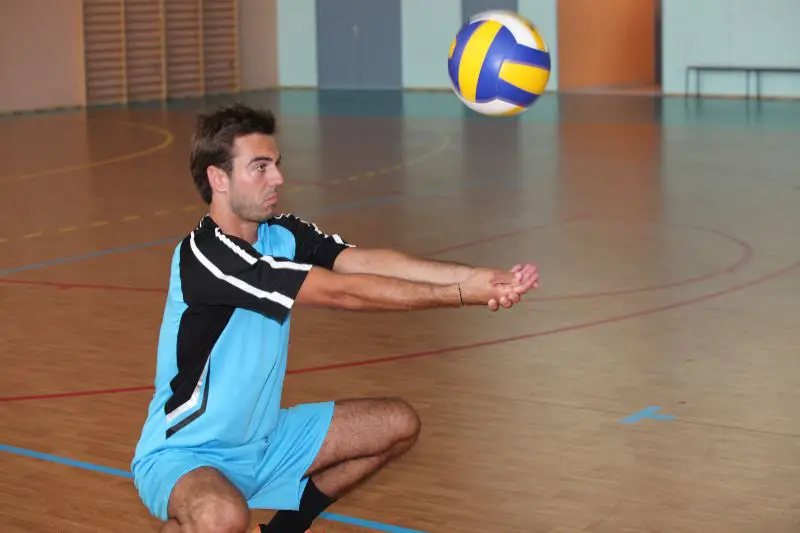
Receiving is usually the starting point of each volleyball attack. If done properly, it usually gives the team an edge to perform a successful attacking sequence …
The move might look easy, yet it is quite difficult and requires consistent practice!
In this article, I am going to focus on how you can improve your receiving abilities in volleyball alone without the need of a partner.
This will give you more possibilities to practice in case you don’t have available training partners.
What you will need to practice?
The first thing that you will need is some space. If you plan on practicing indoors, on the court where your regular practices are held then I guess you are good to go. If you plan to practice outside, on the grass for example, then look for some space where there is no people around.
Then of course you will need a ball, you can check my favorite ball for practice here at Amazon.
The third element you will need is a bucket. As funny and strange as it may seem, a bucket is needed for practicing receiving alone.
One last thing if you are going to practice in the court, then it is preferable to use proprietary volleyball shoes (Check this example). The main benefit here is the Grip. Indeed, to be able to properly receive the ball you need to have a good grip which is well provided by volleyball shoes.
3 Drills to practice receiving in volleyball by yourself
Drill 1: Ball control
Ball control is extremely critical while playing volleyball. Without it, the ball can go in any direction, effectively missing your teammates, or going in the opposite direction of what is than planned.
Ball control can be practiced with the mystery bucket that I have mentioned above. Place the bucket on any distance you deem to be effective. Start by hitting the ball a few times up and down, just to get the feeling and to warm up. Aim for the bucket when you hit the ball. The goal is to place the ball in the bucket.
The bucket is there to help you with your precision, and to help you to aim better.
Drill 2: High and low reception
High and low reception are 2 different sides of the same coin …
- High reception is when you make a diamond with your hands, and receive the ball as if you were passing it.
- Low reception is when you receive the ball with a pump pass, or dig.
This drill is practiced virtually in the same manner as before, be it the outdoors or indoors. You will need the bucket for practicing your precision again, but there are a few more things that need to do.
High reception is, as mentioned earlier, performed in the manner of a pass. However, high reception enables you to receive the ball while being on the move. This does not mean that you can receive the ball while you are running, but you can receive it while on the go, at a slow pace.
High reception enables you to be more flexible while receiving the ball. When practicing alone, you can always pass the ball to yourself, or kick it back from a wall. The goal is to again, practice your ball control and receiving.
Low reception on the contrary enables you to make a more precise and a more concentrated reception. It is crucial that you lower your body weight, putting your hands into the bump pass position. It is also crucial that you remain stationary in order to get the best results.
Low reception may prove harder to practice alone because of the stance you will need to take, but it is not impossible. You can again kick the ball back using a wall, or you can pass the ball to yourself, eventually making a low reception stance.
Drill 3: Wall bumping
Wall bumping is a drill that can get monotonous really fast. The basics of this practice revolve around you, the player and a wall.
It all comes down to ball control again and precision, but it is a good practice when you are alone and want to practice.
In order to perform this drill as best as you can you will need to find a tall wall. The tall wall is there to enable you to send the ball as high as you want. So basically you will need to bump the ball a few times up and down to get the feeling right.
Next you would want to send the ball to the wall as fast as you can, in order to get the ball back as fast as possible. After the ball starts going back to you, you will need to perform a high or low reception, depending on the ball trajectory.
Can you practice those drills at home?
All of these drills can be practiced at home, the only thing that you will need is some space. A back yard is definitely a great option if you have one.
When we talk of practicing those drills at home, it is crucial to know that you can practice them outside, not in the inside.
The first drill that we have mentioned can be practiced at home or outside, with no restrictions. A box will always be found somewhere around the house.
The second drill regarding the low and high reception can also be practiced in your yard with no problems. This drill requires less space than the first one, because you can do it in a small space.
The third drill can be practiced at home as well, under the condition that you find a high enough wall in order to pass the ball to yourself, that is to bump it a gains the wall. The spacing is crucial here because you will need to find a bigger wall.
A bigger wall will provide you with the necessary width that you will need in order to go back and forth when practicing, because no ball is ideal during a game, remember that.
Finally, you can check those other volleyball drills you can practice at home! These covers other important skills …
How often should you practice receiving alone?
Those drills are there as a filler, meaning, that they are intended to be practiced when you want to enhance some of your skills, such as your low reception stance, your ability to hit the ball better and your precision.
These drills can be practiced alone, but it is always better if you practice receiving with other players and with your coach. Your teammates can help you substantially.
Every player that makes a serve has different strength, meaning that your teammates who serve you the ball will always serve differently, giving you enough diversity with the ball. Contrary to a wall, which can provide you with a monotonous back and forth play.
The conditions that need to be met are as follows. You will not have any teammates around or available, you will need to have the will to get better and to get to know your gameplay by yourself, with no interference, and practicing alone will provide you with the needed maintenance of your skills.
Finally, you can check those other volleyball drills you can practice alone! These covers other important skills …
Final Thoughts: Are those drills enough to become great at receiving?
No those drills are not enough to become professional at receiving or bumping the ball. The case here is simple, you can practice alone, but as I have mentioned earlier, you will gain no new skills or techniques.
The alone practicing is here to fill up the gap when there are no teammates around, but you should not rely on that alone. A teammate is always a good addition to your practices.
I have mentioned earlier that teammates can help you get better at your receiving. Every player in volleyball tends to serve the ball differently, meaning that you can receive the ball every time with different intensity.
